
Symbols and Mantras
One of the foundational elements of the reiki system, in addition to hands-on healing techniques, is the symbols and mantras, and in this chapter, we’ll look at both traditional and non-traditional symbols and the many different ways you can incorporate them into your reiki practice.
Secrecy and Reiki Symbols
As with many aspects of the system, there is a fair amount of controversy surrounding the symbols, starting with whether or not they should be shared with the public. The main reason for keeping the symbols private is to honor the tradition that they only be shown to students, specifically students who have reached level two of their training, which is when the first three symbols are typically taught (the fourth symbol, if it is taught at all, is reserved for the master level). It is seen as a matter of respect to keep the symbols secret.
I’ll admit that as a lover of the mystery school model of teaching, I like the idea of special symbols reserved only for initiates—and perhaps if we lived in a different, internet-free age, this privacy could have been maintained—but the reiki cat is well and truly out of the bag at this point (and running freely about the neighborhood). Some teachers maintain that even if someone sees the symbols outside of a level two training, they wouldn’t be able to use them anyway, because the second-degree attunement serves to activate the symbols. Having learned of this controversy only after taking my second degree, alas, I can’t run a personal experiment to determine if I sense a difference in using the symbols before and after, but my belief regarding the symbols mirrors my belief around attunements: we aren’t somehow barred from accessing these energies without the “right” instruction or ritualized processes, but our experience of them is very likely enhanced following instruction and attunement.
Symbols in Early Reiki Teachings
As discussed in a previous chapter, it appears that Usui did not use the symbols in his early teachings, but they were added later (likely around 1922) to assist students with less experience in sensing energies. We do not see the symbols in the Reiki Ryôhô Hikkei, and it is said that the students copied the symbols from their teachers.1 Rather than a one-size-fits-all approach, students would be given symbols and mantras based on their level of ability to help them experience and internalize the teachings. This is akin to tailoring directions to your house based on the recipient: a more visual person might prefer a map or description of landmarks, while someone else would find an ordered list of street names easier to navigate. From this perspective, it follows that one mustn’t get overly attached to the signposts. They’re useful tools, but they’re not the sole means of finding our way, nor are they the way itself.
Hiroshi Doi, founder of the Gendai Reiki system discussed in Chapter 7, writes that the system he learned at the Gakkai included the symbols (called ho or hi-ho) but not the mantras, which Doi refers to as kotodamas.2 Kotodama means “words carrying spirit” and can be thought of as the sacred sound and power that resides in a word. A similar term is jumon, which is sometimes used interchangeably with mantra. Jumon is “a sound that invokes a specific energetic vibration,” and both kotodama and jumon are concepts found in the indigenous Japanese religion of Shintô.3 They are seen as ways to interact with elements of the world in a very deep way, by tuning in to their inherent vibrations. For example, by deeply listening to and attuning with the sound of a burbling creek, you can come to know the creek more than you could simply by looking at it, wading into the water, or reading a book about creeks. In a similar fashion, the mantras in reiki can help us attain a deeper, more profound understanding of the energy, giving us a primal, embodied understanding that goes beyond purely mental concepts and ideas.
Using the Mantras
Many teachings suggest chanting each mantra three times while drawing or visualizing the corresponding symbol, but you can also chant the mantras without the symbols. I like to chant until I feel the sound really resonating in my body and continue chanting for as long as this resonance feels right—sometimes for only five or six rounds, other times as long as ten minutes or more.
Reiki Symbols
In the West, the symbols are often given the name of the associated mantras, even though the symbols and the mantras are distinct. In Japan, the symbols are numbered and simply called Symbol One, Symbol Two, and so on, and we will be following the same convention here.
Symbol One
The first symbol is sometimes called the Power Symbol, and it is said to focus and amplify energy. It’s associated with earth energy, and thus has a grounding effect, bringing energies back into balance with the natural rhythm of the earth.4 This symbol is said to stimulate the hara, the energetic center in the lower belly, which also enhances the sensation of being grounded. This spiral symbol has parallels in other cultures, where variations of the symbol are often used to denote the movement of energy.5
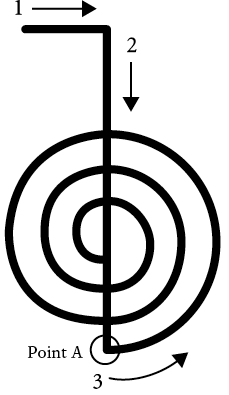
Figure 46: Symbol One, Choku Rei
This symbol can be used in a number of ways, most of which center on the theme of focusing reiki in a particular area. For example, you can draw the symbol with your finger over a body part, in a physical space (such as your desk before sitting down to work), and over food and drinks to concentrate reiki and its healing effects. Gendai Reiki founder Hiroshi Doi considers it to be useful in the area of business and money given its earth associations, and he suggests drawing the symbol over bills; over your wallet, cash, or credit cards; or before engaging in business activities. He also recommends Symbol One for purification of self, space, or objects. Some teachers feel that Symbol One is necessary to activate or “anchor” Symbol One and Symbol Two and that they cannot be used without it, but I have not found that to be the case in my own practice.
Non-traditional Use
The symbol doubled, with the one on the left reflected so that the top lines of both symbols are facing inward, creating a gate-like structure, is said to be a powerful tool for manifestation. See also the Kriya symbol (see page 167) in the Karuna Reiki section.
Mantra: Choku Rei
The mantra associated with Symbol One is Choku Rei, pronounced CHO-koo-ray, and the symbol is used in misogi, a form of purification in Shintô practice. “In this context, choku means ‘straight’ which conveys the idea of ‘honest.’ ” 6 In my own experience with the mantra, I find it useful in removing all but the essential elements of a situation, allowing me to focus on what is most important, which is, in a way, a form of purification. In both the Oomoto and Byakkô Shinkôkai religions, the mantra literally means “Direct Spirit.” It is seen as a part of the divine that resides within each of us. It is also translated to “imperial order or command” or “supreme spiritual emptiness (void).” 7 I internalize these meanings as the realization of one’s divine nature (in other words, recognition of the Direct Spirit) removes the illusion of separateness and temporary form, giving rise to a supreme “emptiness” in which all is one. Connecting this to the energetic spiral of Symbol One, when illusion falls away, this allows one to see the great spiral of energy moving through all things.
Symbol Two
This symbol is sometimes referred to as the mental-emotional symbol in modern teachings, while traditionally it was said to have the energetic quality of harmony. It is associated with the moon, yin energy, and the element of water, and Doi relates these concepts through the tides, which are caused by the gravitational force of the moon, which, in turn, is said to affect the water within our bodies. While the first symbol helps us find balance by synchronizing us with the energetic rhythm of the earth, the second symbol harmonizes our energy with the rhythm of the moon. The moon is often associated with the emotions and intuition; thus, this symbol is said to bring healing on an emotional level and strengthen our intuition.
Use this symbol to relieve physical or mental tension, to release blocked emotions and clear up confusion, before meeting people or to heal relationships, to initiate forgiveness of self and others, to receive spiritual guidance, and to release negative habits. You can follow Symbol Two with Symbol One, as the second symbol is believed to have a certain fragility, subtlety, or gentleness to it that must be anchored by the first symbol.8 I have not found this to be strictly necessary, but experiment and do what feels right to you. It is also associated with the solar plexus and heart chakras and is said to be quite healing to these energetic centers.

Figure 47: Symbol Two, Sei Heki
Non-traditional Use
This symbol, doubled and drawn upside-down, is said to balance the left and right hemispheres of the brain.
Mantra: Sei Heki
The mantra associated with the second symbol is Sei Heki, pronounced say-hay-KEY. Reiki master Penelope Quest equates it with the meaning “to make things straight … to restore balance,” and Frans Stiene says it is “our inclination to remember our True Self.” 9 The two meanings make sense when you consider that remembering one’s True Self will restore balance, and this also speaks to healing on an emotional-mental level, because so many of the disturbances in this area stem from forgetting our true nature. When we become overidentified with the limited self-perception of the ego, this can generate all manner of imbalances, often stemming from the false core belief that we’re unworthy or somehow not enough. When we remember our True Self, we have a deeply felt sense of our innate worth, which heals the otherwise punishing drive to prove ourselves, perhaps by overworking, mistreating our bodies, competing in relationships, or spending the majority of our time on shoulds and have tos over doing what truly nourishes and inspires us.
Working with the mantra on a regular basis is a means of continually recalibrating our energy with that of divine harmony, supporting us in meeting life’s diverse challenges with more equanimity. Over time, this boosts our mental and emotional resilience, as we witness our increasing ability to respond mindfully instead of reacting thoughtlessly. From this place, we become less concerned with expending vast amounts of energy trying to control life, and instead, we trust that whatever comes our way, we will have the creativity, strength, and capacity to deal with it.
Symbol Three
The third symbol is sometimes called the Distance Symbol and can be used to send reiki to other times and places. This symbol is associated with the sun, transcendent consciousness, and the meaning “I become one with God.” 10 It is described as a “bridge between worlds,” uniting the above and below, inner and outer, heaven and earth, and transcending any separations between time and space.11 Rather than thinking of reiki as being sent like a letter or even a beam of light, I see this symbol as a tool for recognizing (or remembering) that separation is an illusion, that everything is one; thus, in a sense, there is no “here” nor “there.” Reiki doesn’t need to be “sent” anywhere, because it is already there. You might think of Symbol Three as a way of tuning in to the reality of oneness before, for example, doing a healing for someone who is not physically present, thereby dissolving any false perceptions that you aren’t connected to this person simply because of geographical distance. Like the other two symbols, Symbol Three is another signpost pointing us toward the underlying nature of reality: oneness. This symbol is said to be especially useful in healing the fifth and sixth chakras, as they are related to our ability to communicate and connect. Some teachings state that it cannot be used on its own and must be paired with Symbol One and sometimes Symbol Two. I have not found this to be necessary in my personal practice, but experiment to see what works best for you.
Frans Stiene offers another translation of Symbol Three, “I am right mind,” which he equates with the realization that distance and separation are an illusion.12 One aspect of a right mindfulness practice is witnessing our tendency to label things: This is good. That’s bad. Friend versus foe. Right versus wrong. “When we have a direct experience of Right Mindfulness, we begin to stop labeling things. We just see things as they are, and we don’t get carried away by our dualistic thinking.” 13 This transcendence of opposites leads to healing, in large part because it allows us to see our fullness of self rather than scooting under the rug any parts within us that don’t conform to our ideals. These rejected aspects are denied the light of consciousness, like a plant hidden from the life-giving rays of the sun, and they become stagnant—caught, as it were, in a time loop where they cannot grow and change. When we invite these parts home by healing the dualistic belief that we can be either good or bad, these stagnant areas are transformed. It is in this capacity that I relate to another one of Symbol Three’s associations: that of healing the past and purifying karma.
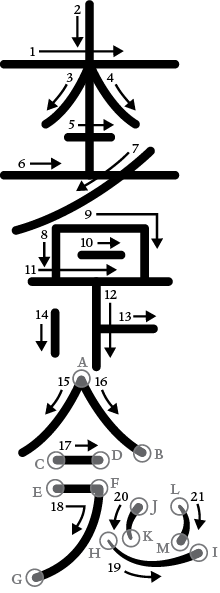
Figure 48: Symbol Three, Hon Sha Ze Sho Nen
To use Symbol Three, Doi recommends drawing the symbol in the air once while repeating the mantra Hon Sha Ze Sho Nen, three times. You can do this on an object or a photo of someone to whom you wish to “send” reiki (or a slip of paper with their name written on it), and then hover your hands over the object or photo and allow reiki to flow. You can also give yourself “distance” reiki by drawing the symbol, chanting the mantra three times, and choosing three positions on your body. With your hands on the first position, say, “Head,” and give reiki. With your hands on the second position, say, “Front,” and finish with the third position, saying, “Back.” 14 This allows three positions to stand in for a full-body treatment, which is wonderful when you’re short on time or when your flexibility or reach prevents you from using the standard hand positions.
Non-traditional Use
Drawing Symbol Three twice (“doubling” the symbol) is said to heal future lives.
Mantra: Hon Sha Ze Sho Nen
The mantra associated with the third symbol is Hon Sha Ze Sho Nen, pronounced HONE-sha-zay-sho-nen. Stiene gives the following translations:
Hon: True, book, origin, real, to find the origin in
Sha: Person, someone, the one (who/which), he/she who is
Ze: Right, correct, just so, this, justice, perfectly, it is this
Sho: Correct, true, straight, the basis of correct knowledge, righteous
Nen: Thought, feeling, mindfulness, mind, memory, meditative wisdom, patience, forbearance 15
I encourage you to meditate on these translations, combining them in different ways like a divine word jumble to see what messages arise for you. One meaning that resonates with me is “meditating on the nature of the True Self allows us to reclaim our original wisdom.” In other words, Hon Sha Ze Sho Nen acts as yet another signpost, guiding us back to our True Self. And another: “Our original self, our True Self, is perfect, just as it is, and meditating on this truth gives rise to wisdom.” What meaning resonates with you?
Symbol Four
Sometimes referred to as the Master Symbol, this symbol may or may not have been part of Usui’s teachings; as with many aspects of reiki, its origins are surrounded in controversy. According to Frans Stiene, Hiroshi Doi knew of a student who learned this symbol from Usui, and both Chûjirô Hayashi and Hawayo Takata knew and taught this symbol as well.16 Stiene surmises that not all students were taught this symbol based on their level of readiness, which is reasonable given that we know Usui adapted many of his other teachings to fit the experience level and aptitude of individual students. Masaki Nishina asserts that this symbol was not a part of Usui’s original teachings and claims it is a “Western technique developed in the Western community by somebody who knew a little about the Japanese language,” and he offers that it might have been Takata who developed it for her master-level students.17
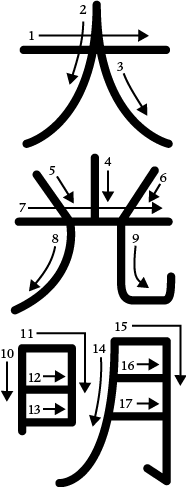
Figure 49a: Symbol Four, Dai Kômyô
This symbol is not exclusive to the system of reiki, and it can be found in temples throughout Japan. It is used in the Mikkyô teachings of Tendai Buddhism to help one merge with the “Light Wisdom of the original Buddha nature,” and it is also found in  , Sekai Kyûsei Kyô, Kurama Ko Yo, and various martial arts.18 This symbol is associated with the universe and God, and with the union of the sun and the moon. It can be used in conjunction with any of the other symbols to make them “finer and more harmonious” and can be used first to achieve this effect.19 This symbol can be used for purification, for example, by drawing the symbol before meditation, breathing exercises, or practices such as qigong, and it will surround your endeavors with light, making it a great symbol to use before doing just about anything: going to work, giving a presentation, making an important decision, creating art, and so on. Use the fourth symbol if you are having trouble with something and you seek higher guidance. You might draw the symbol before bed, asking for guidance on a particular issue, and giving yourself reiki until you fall asleep. When you wake up, redraw the symbol and reaffirm the intention that your every thought, word, and deed are divinely guided before going about your day.
, Sekai Kyûsei Kyô, Kurama Ko Yo, and various martial arts.18 This symbol is associated with the universe and God, and with the union of the sun and the moon. It can be used in conjunction with any of the other symbols to make them “finer and more harmonious” and can be used first to achieve this effect.19 This symbol can be used for purification, for example, by drawing the symbol before meditation, breathing exercises, or practices such as qigong, and it will surround your endeavors with light, making it a great symbol to use before doing just about anything: going to work, giving a presentation, making an important decision, creating art, and so on. Use the fourth symbol if you are having trouble with something and you seek higher guidance. You might draw the symbol before bed, asking for guidance on a particular issue, and giving yourself reiki until you fall asleep. When you wake up, redraw the symbol and reaffirm the intention that your every thought, word, and deed are divinely guided before going about your day.
The mantra associated with the fourth symbol is Dai Kômyô, pronounced die-CO-myo. It is said to be useful in healing the seventh (crown) chakra and connecting to higher sources of guidance, and it is often translated as “great bright light.” The kanji for dai represents, in certain esoteric traditions, the five elements: earth, water, fire, air, and space (or void), and for me, this speaks to the unifying effect of this mantra. When we see ourselves in the “great bright light” of divine consciousness, we see all our parts, all our internal elements, as one unified whole—in other words, we see our True Self. Similar to Symbol Three, this mantra is another signpost or tool that helps us shed the layers of illusion created by the mind, illusions that cause us to label parts of ourselves as unacceptable, creating self-rejection, suffering, and dis-ease. The light of Dai Kômyô can trigger remembrance of our own inner light, dispelling the shadows of ignorance that have led us to forget our True Self.
This mantra can be used for purification—for example, a Mikkyo practice involves chanting the mantra “to overcome inner obstructions such as worry, fear, or attachments,” and some practitioners use it to clear self and space prior to giving a reiki treatment or reiju.20 This mantra is also associated with the quality of empowerment, which can range from using it to “supercharge” any of the symbols to a deeper form of empowerment arising from remembering one’s True Self. One practice I particularly love is chanting Dai Kômyô every morning for a twenty-one-day period. When you’re in need of a serious reset or simply wish to go deeper with the mantra, I highly recommend giving this a try. You might be surprised at the insights that arise and the shift in your baseline energy!
Symbol Four Alternate: Dai Kômyô (Tibetan Version)
This is an alternate, non-traditional version of Symbol Four, also known as Dumo or the Tibetan Master Symbol. It is said to be more intuitive for Westerners to work with, and Maya Cointreau writes, “Many feel that it has a gentler way of healing, yet gets to the root of dis-ease more quickly and is more powerful.” 21

Figure 49b: Symbol Four Alternate, Dai Kômyô (Tibetan version)
New Reiki Symbols
Throughout reiki’s journey from Japan to the rest of the world, different practitioners have adapted the practices in a variety of ways, and some of those adaptations have introduced new reiki symbols, sourced either from previously existing spiritual traditions or through meditation and channeling. Traditional practitioners assert that these symbols are not part of reiki, but it’s up to each practitioner to decide what works for them. If you feel so called, experiment with the new symbols to see if they enhance your reiki practice. You can also explore using sacred symbols from other traditions, such as the Egyptian ankh, the Celtic triskele, or Norse runes, to see how they affect your energetic experience. Some practitioners feel that non-traditional symbols are potentially harmful, and if this is a concern for you, set the intention that your explorations unfold in accordance with the highest good, harming none.
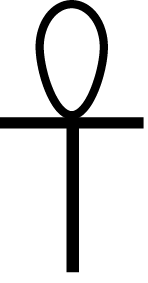
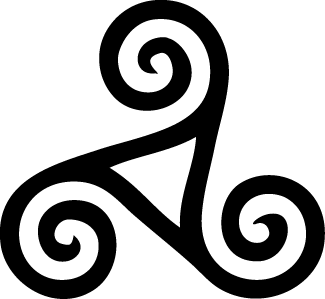
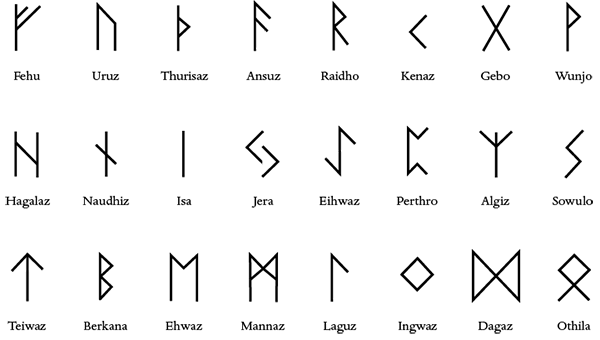
Figure 52: Elder Futhark runes
Karuna Reiki Symbols
The following symbols are found in the Karuna system of reiki, covered in Appendix B
Gnosa
The word gnosis is Greek for “knowledge,” and the word is commonly used to refer to knowledge of esoteric or spiritual matters. This symbol helps to clear away preconceived notions and false beliefs, creating space for deeper understanding to arise. Thus, it is very useful when learning new things, be they physical skills, mental information, emotional understandings, or spiritual truths. Gnosa can heal communication, and, by extension, the nervous system, which is one of the body’s central communication systems. Gnosa is pronounced NO-sa.
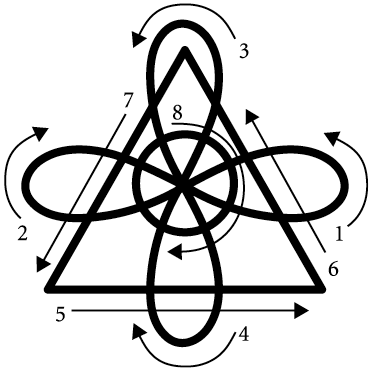
Halu
After the practitioner uses Zonar (see page 174) to prepare the recipient for deep healing, Halu is used to find areas that are holding on to unhealthy patterns, which Laurelle Shanti Gaia perceives as tangled energetic shapes and strands. When the energy of Halu reaches these obstructions, “the tangles appear to relax and unravel.” 22 This symbol is also used to identify and heal our shadow aspects, which are those parts of ourselves that we repress or deny, and they can include not only unhealthy facets but also hidden gifts and awareness. Thus, this symbol is a powerful tool for fostering self-acceptance. Visually, this symbol looks like Zonar with a pyramid added, and this addition is said to be one of the mechanisms by which Halu amplifies the energy of Zonar.
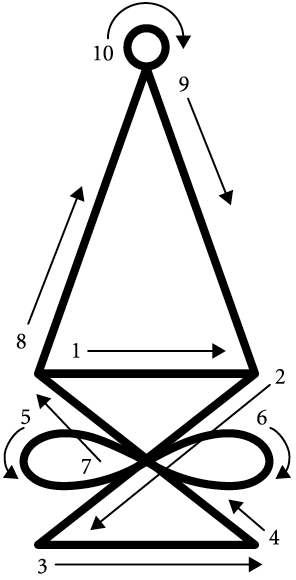
Harth
This symbol represents universal compassion, and Laurelle Shanti Gaia sees this symbol as the heart of Karuna Reiki. She explains that we cannot truly have compassion for another being until we have compassion for ourselves, and work in this area can support healing in our relationships. While it might sound contrary to the concept of oneness, part of this healing often involves setting clear boundaries, and this parallels the work of researcher Brené Brown, who asserts that we cannot truly have compassion for others without healthy boundaries, because the person who allows the world to treat them like a doormat is usually cradling a simmering pot of resentment.23 Shanti Gaia offers a unique way to use Harth for relationship healing by choosing a crystal or other object to represent the energy of the relationship. Use the traditional Usui Symbol Three, Symbol Two, and then Harth before sending reiki to the relationship via the crystal.24

Iava
Another symbol from Karuna Reiki, Iava (pronounced EE-ah-vah) helps us connect to and heal with the earth, nature spirits, and devas. This symbol helps us see that we are active creators of our reality, and if we embrace this truth, we will find empowerment through this symbol. It can help heal codependent relationships through the establishment of healthy boundaries while simultaneously experiencing the interconnectedness of all beings. The first three spirals are said to represent the energy of the triple goddess, sometimes referred to as the maiden, mother, and crone aspects, and the four loops on the right-hand side represent the elements of earth, air, fire, and water.
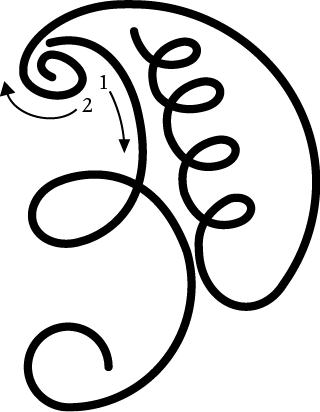
Kriya
This is a double traditional Symbol One, which is said to supercharge the manifestation process, and it is related to the Kundalini yoga practice of kriya, which is used to create change on all levels of your being in order to bring about a specific desired outcome, such as aura purification, liver detoxification, or elevated energy levels. You might think of them as spiritual protocols to achieve a particular end goal. The Kriya symbol is associated with the earth element, and it is a powerful tool for grounding, which is also related to manifestation, as this can be viewed as the process of taking our desires and grounding them in tangible reality. When drawing with your fingers, you can create both right and left symbols simultaneously. If drawing on paper or if doing both is difficult, I like to start with the right-hand symbol and then draw the one on the left, but use whichever order feels best to you.
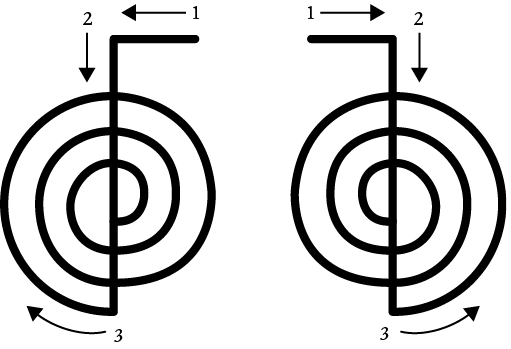
Motor Zanon
Some sources claim this symbol has Tibetan or Sanskrit origins, and it is taught in Seichim Reiki and Karuna Reiki, with some traditions referring to it as the Antiviral Symbol for its ability to attach to and remove viruses. To use Motor Zanon, first draw the traditional Symbol One once and chant the Choku Rei mantra three times. Then draw Motor Zanon once, chanting “Motor” three times, then finish by drawing Symbol One and chanting Choku Rei three more times. Christopher Penczak recommends visualizing the symbol entering the recipient’s body where the corkscrew shape will spin, “attracting viral particles, filling the funnel shape. Use your intuition to know when to take it out.” 25 To remove the symbol, chant Choku Rei three times, then “Zanon” three times, finishing with three intonations of Choku Rei as you visualize drawing the symbol out of the body. When you’re done, purify the energy by using Halu or simply visualizing it dissolving in pure, white light.
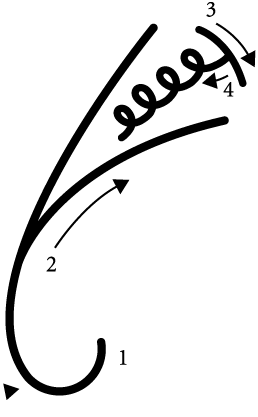
Om
This ancient Sanskrit symbol has been adopted by Karuna Reiki, and it represents the oneness of all creation, hence it can be used to initiate a powerful feeling of integration, harmony, and unity with all beings. The dot symbolizes the detachment of the true essence from its creation, so this symbol can also be used to support healthy detachment—for example, if we find ourselves stressing over a particular outcome and attempting to control and micromanage situations and people.
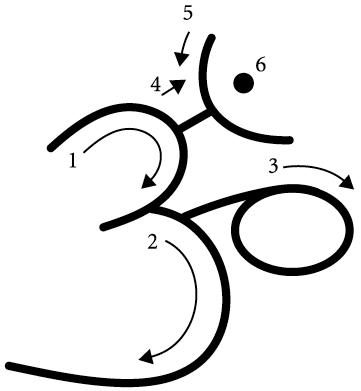
Raku
The Raku symbol is also known as the Fire Serpent or Completion Symbol. It can be used during treatments and attunements to align the energy through the chakras and remove obstructions, while some practitioners claim it activates kundalini. Used at the end of a session, Raku aids in settling the body and bringing a sense of grounding and completion.

Rama
This symbol is the final symbol in level one of Karuna Reiki, and it is a powerful tool for harmonizing the upper and lower chakras, bringing healing to the entire energy system. Rama calls all of a person’s energy back into their body for integration, similar to the shamanic concept of soul retrieval, in which the soul, in whole or in part, has been separated from the body, often due to trauma, and must be brought home. This symbol has a strong grounding force and can be used at the end of a session to bring the recipient fully back to the here and now. You can use this symbol to navigate abrupt change, such as changing time zones when traveling or unexpected life events.26 The five loops of the symbol represent the five elements, and the two intersecting lines represent polar creative energies; some associate this symbol with Archangel Michael.
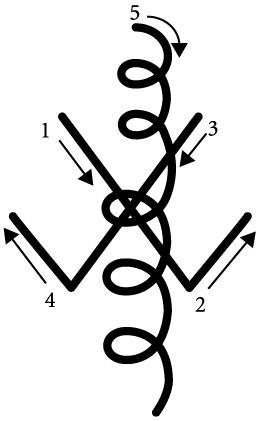
Shanti
This is a Karuna Reiki symbol that brings peace of mind, and it is named after the Sanskrit word for peace or tranquility. Shanti can support us in releasing attachment to things outside of our control, finding calm in the present moment. It can heal insomnia, chronic fatigue, and fear, and it is said to open the chakras and bring about clear psychic insights when we meditate on the symbol entering the third eye chakra.

Tibetan Fire Serpent
This Karuna Reiki symbol is sometimes referred to as Raku or the Fire Dragon, and it is said to represent kundalini energy coiling through the seven chakras. It can be used to balance the energy system and to prepare oneself for reiki sessions and attunements. Depending on the manner in which it’s used, some practitioners assert that it can both ground energy through the lower chakras or raise energy in the upper chakras, and it may map the energy pattern experienced during an attunement.
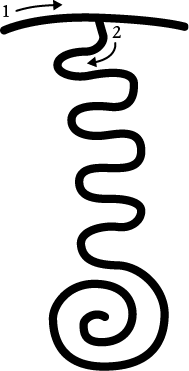
Figure 63: Tibetan Fire Serpent
Zonar
A level one symbol in Karuna Reiki, Zonar is said to pave the way for deeper healing, and it addresses multidimensional issues, such as those rooted in past lives. It can release negative emotions, such as fear, hate, and shame, that are trapped at a deep cellular level, and it is associated by some with Archangel Gabriel, who is connected to healing. Reiki master Laurelle Shanti Gaia uses Zonar at the start of a treatment, as she feels it acts as a “spiritual anesthetic,” preparing the recipient to receive reiki into their subtle and physical bodies with little to no discomfort.27

Seichim Symbols
The following five symbols are found in the Seichim system of reiki, covered in Appendix B.
Cho Ku Ret
This is the power symbol of the Seichim tradition, and it transforms the spiral energy at the heart of the traditional Symbol One into an infinity symbol. Cho Ku Ret can be used to heal not only people, animals, and plants, but also “non-cellular beings,” such as crystals and machines. It is sometimes referred to as the Inanimate Object Power Symbol or Zara, and similar to Symbol One, it is used to focus and direct energy to the healing subject.
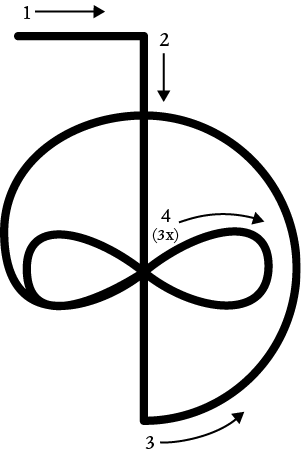
This symbol is associated with realizing one’s full potential, what some refer to as the individual’s angelic divinity, so it can be shared for the benefit of all beings. This symbol helps us connect with angelic beings and higher spirit guides, and it can be used to draw protection from those realms. The first diagram depicts the traditional way of drawing the symbol, and the second is a method I have found to be effective in my personal practice. I use the latter when tracing the symbol in the air—use both index fingers and begin at the left and right starting points, bringing your fingers to meet at the top.

Male Female
This symbol balances forces of polarity and helps us see opposing points of view. It can also heal the effects of societal gender constructs and open us up to a more expansive perspective and sense of self. It also goes by the names of Everlasting Flower, Yin-Yang Balance, and Everlasting Flower of Enlightenment.
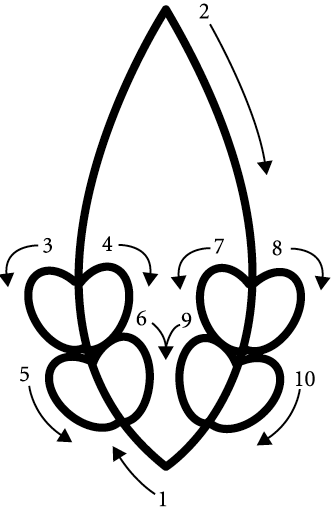
High-Low-God
Another symbol from Seichim Reiki, this is said to align the higher and lower self with the divine, integrating your entire being with love and light. It initiates powerful change in your life, illuminating any aspects that are not in alignment with your highest good so you can bring awareness and healing to them.
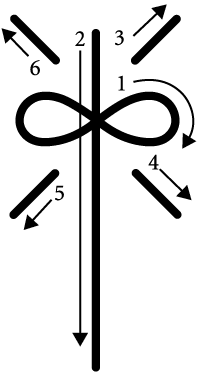
Eeeftchay
Sometimes spelled Ift Chei, this Seichim symbol represents “endless inner sight” and is used to shed light on any issue, bringing clarity and understanding. You can draw the symbol over individual chakras to illuminate issues related to that energy center, and when drawn over the third eye, Eeeftchay activates natural psychic faculties.
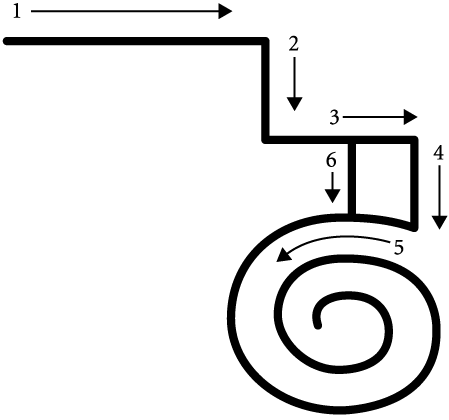
Otherkin Symbols
The following symbols were channeled by Corey Thorn, a practitioner of the Otherkin and Opensource Reiki traditions.28 Drawing instructions aren’t given, as the symbols are meant to be drawn intuitively, as each practitioner sees fit.
Akinara
This symbol is associated with enlightenment.
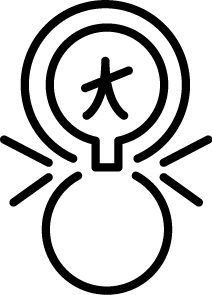
Go She Ki
This symbol can be drawn on areas of inflammation and joint pain or over the entire body to heal general inflammation. It is said to be useful in treating carpal tunnel syndrome.29
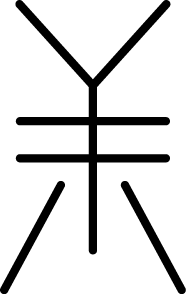
Ho Ta Li
This symbol is said to gather and store energy, and when the symbol is added to one’s personal protection shield, the stored energy will remain until it is triggered by another person’s negativity. The energy will then work to counteract this negativity with positive energy.
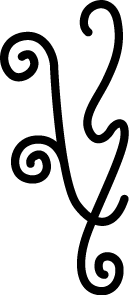
Kainar
This symbol is said to be grounding and centering.
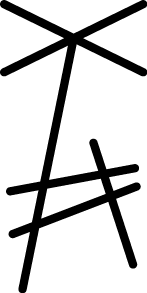
Kita No Kaze
Also known as the North Wind symbol, Kita No Kaze helps you tap into the element of air, bringing a breath of fresh air to your energy field, helping to clear away stagnation and introducing change.30
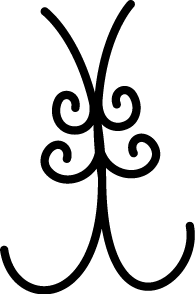
Koshalin
This symbol opens the chakras in preparation for an attunement.
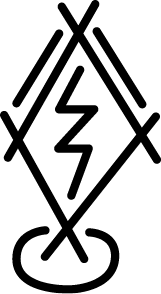
Kyu So Na
This symbol protects against harmful mental influencing, such as brainwashing, and can heal the mental and emotional damage wrought by external forces.
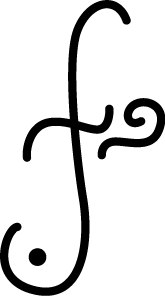
Sei Rea Ko
This symbol can be used to induce rain or to break up cloud formations. It is associated with the energy of the storm master as the bringer, destroyer, and controller.
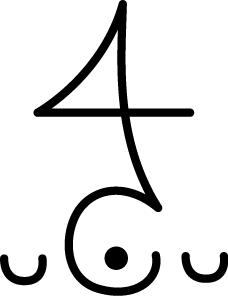
Shimatsu
This symbol clears negative energy surrounding a person, including negative thoughts and feelings, and it can be used as a protective shield against these energies.
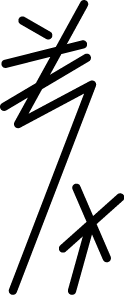
Shonen-Fe
This symbol can be used on its own or in conjunction with Tinara for powerful relaxation. It works on the central nervous system, and can reduce or heal nerve damage while promoting deep relaxation. It may also be useful in lessening the severity and occurrence of epileptic seizures.

So La Kyu
This symbol is said to be useful in the treatment of cancer.
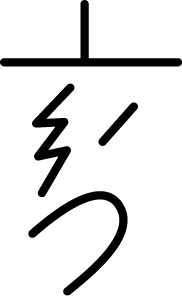
Tinara
This symbol is used to promote relaxation and relieve stress. It can be drawn on the hands before giving massage or placing the hands on an area of the body experiencing muscle tension or cramps.
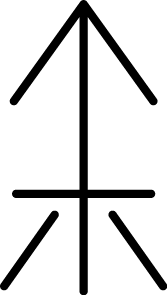
Toh Rai Sin
This symbol is useful in healing the environment, be it a physical place or a mental-emotional environment, and it is effective for both individual and group healing.

Tsuriai
This symbol is used to balance and center, especially when one feels thrown out of whack due to external pressures. Each of the four elements are contained within the symbol: earth by the house-like upper structure, air by the bottom left symbol, water by the bottom middle, and fire by the bottom right. It might be possible to evoke specific elements by drawing specific parts of the symbol.
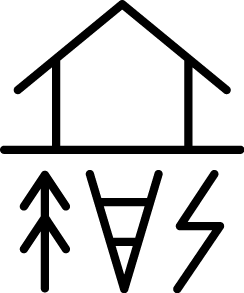
Christopher Penczak Symbols
The following symbols were channeled by witchcraft teacher and reiki practitioner Christopher Penczak and can be found in his book Magick of Reiki.
Al Luma
During a healing session, this can be used to connect the recipient with higher sources of guidance, including spirit guides. Christopher Penczak’s guides call this symbol a “cosmic ark,” as it helps users journey inward, connect with spirit guides, and otherwise release expectations and flow with the experience as it unfolds.31
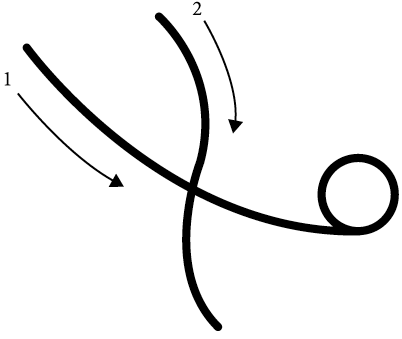
Antibacterial
Penczak channeled this symbol after asking reiki for guidance in healing an infection, and as the name suggests, it is useful in fighting bacterial infections.

Antipoison
Penczak received this symbol while working with Shamballa energy, seeking an effective way to deal with poisons and toxins, such as venomous insect bites.

At Mata
This symbol is used to “cross over into a new threshold of healing,” 32 and it can remove emotional blocks that are obscuring deeper truths.
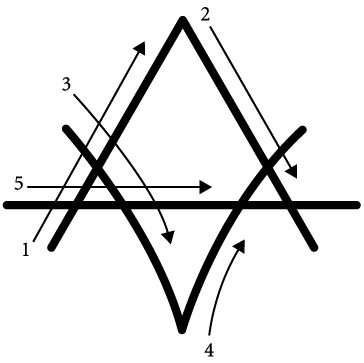
Chakra Symbols
The following symbols are given without instructions for drawing them, so use your intuition to develop a method that works best for you.

Dagu
This symbol is used to balance overabundant masculine energy and provide healing for those who are overly aggressive, hyperlogical, and goal-oriented, while making it easier to honor emotions, intuition, and non-linear process. It is useful for activating the energy of the spiritual warrior archetype.
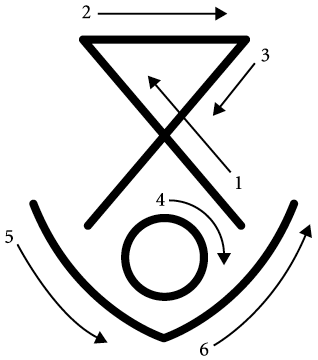
Dai Koko Mi
Penczak received the guidance that this symbol was only to be used in the context of healing initiations to cleanse and open the chakras. The seven outer strokes represent the seven primary chakras.
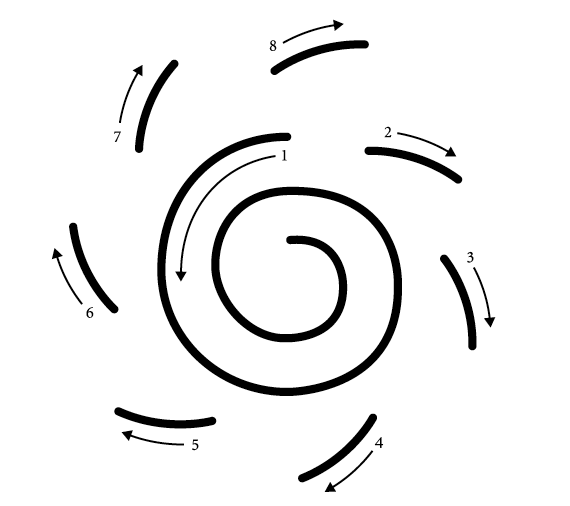
Dazu
This symbol is used to heal on the devic, or nature spirit, level, and it is best used while out in nature. It can be used on plants when harvesting them for healing or magickal purposes, and it is effective in healing ecological disturbances and destruction wrought by humans.
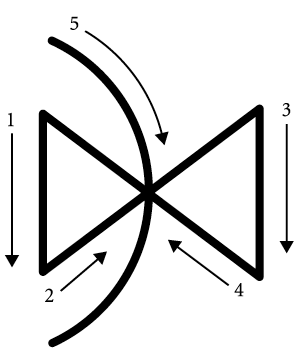
Harmony
This symbol balances the flow and polarity of the energy in the body and aura, and it’s useful at the end of a session to seal and protect, much like the traditional Usui Symbol One.
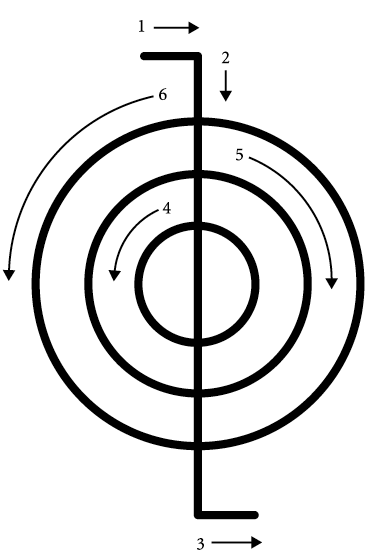
Kir Mall
This symbol is useful in alleviating pain and discomfort. The four loops represent the four elements, so this symbol can be used to bring about internal elemental balance.
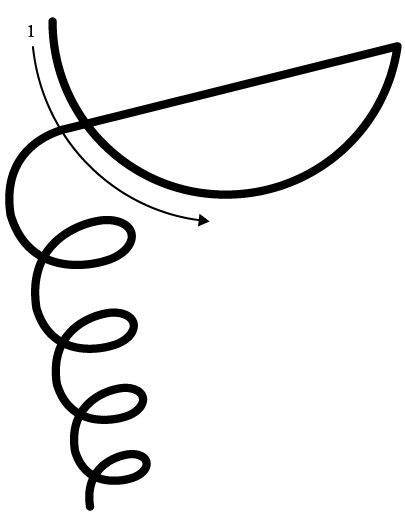
Kundalini Balance
This symbol clears the energetic channels through the chakras, preparing one for a smoother flow of kundalini energy, and it can act to raise one’s consciousness in daily life.
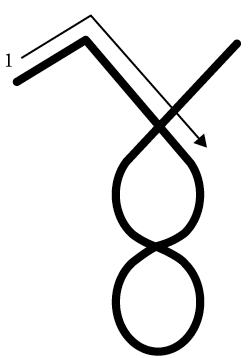
Live Li
This symbol is similar to Motor Zanon, and it can be used to remove unwanted energy of any kind. You can “push” it into the body, where it will form a “three-dimensional tetrahedron with a mouth-like opening,” which breaks up and devours harmful or unwanted energies.33 Chant “Live Li” three times when pushing the symbol into the body, and repeat to call the symbol out of the body.
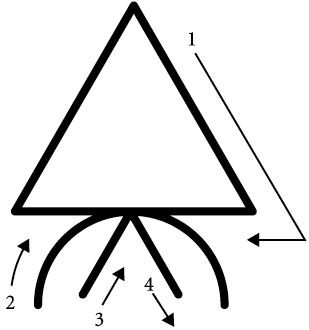
Ra Ta Rio
This symbol integrates polar energies, harmonizing opposites and helping one integrate shadow material.
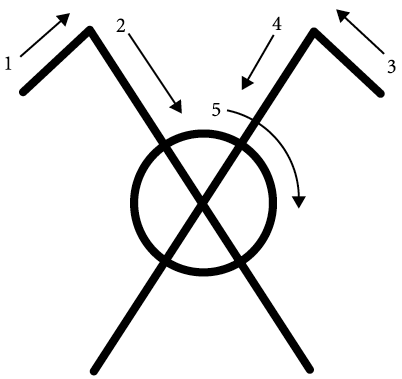
Um Mal
This symbol brings balance and harmony to the physical and spiritual selves and can help one live in more alignment with their spiritual values. It also helps one access deeper emotions and fears so they can be healed.
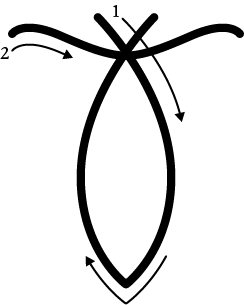
Why Ti
This symbol brings in and helps integrate new energies within the body, while introducing balance to the entire chakra system. It can help one be more open to change.
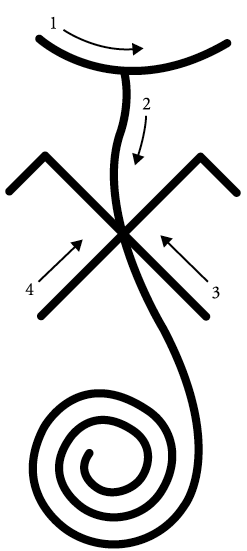
Zen Lu Ma
This symbol can be used to remove deeply entrenched mental and emotional blocks, or physical pain. The symbol will spin and enter the body to clear away obstructions.
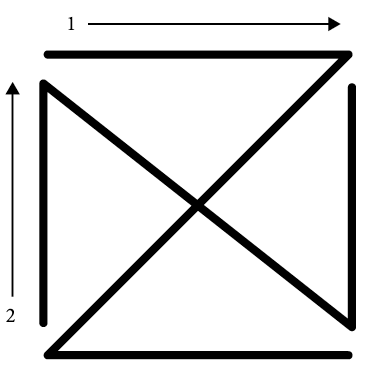
Reikifire Ministry Symbols
The Reikifire Ministry lists a set of fifteen symbols channeled by the late Rajeev Wagle, founder of the Wagle Reiki system.34 There are no instructions, so you will need to use your intuition and experiment when drawing them.
Biru Kai
To increase or create love.
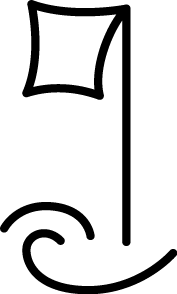
Chi Hai
To ensure success in new ventures.
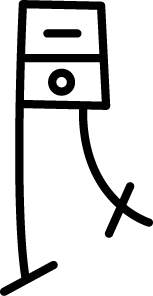
Furu Pyo Sho
To aid meditation.
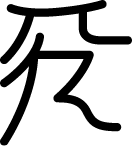
Hang Seng Dor
To remove blockages and challenges; can be placed on walls.

Jai Jin
To aid self-expression.
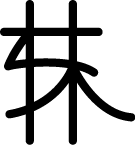
Jin So Gen
To create peace in relationships.
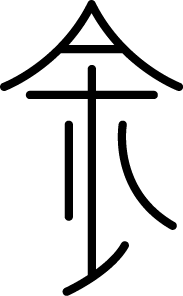
Kat Sei Chen
To alleviate depression.
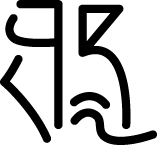
Ki Yin Chi
To increase prosperity; can be placed on walls.
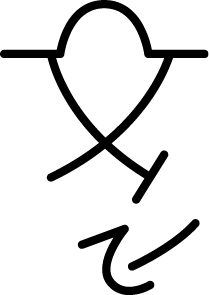
Michi Ka Ro
To harmonize.
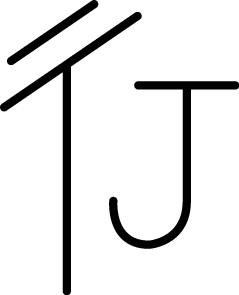
Mil Qu Zoo
To alleviate scarcity.
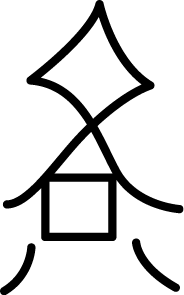
Samye Meldru
Peace.
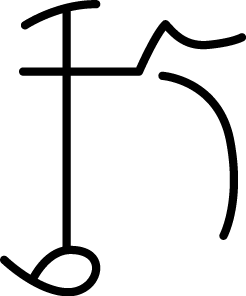
Senz Tan
To achieve victory.
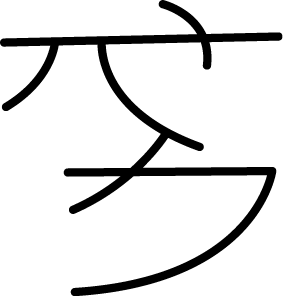
Tse Ne Dong
To promote happiness and ease.

Yoshi Te
To heal relationships.

Zen Kai Jo
To increase abundance; can be placed on walls.
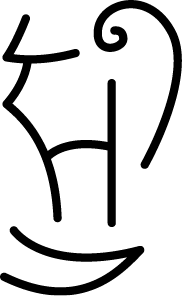
Shamballa Symbols
According to founder John Armitage (a.k.a. Hari Das Baba), there are 1,024 symbols in the Shamballa system, channeled through a being Armitage refers to as Germain, who was said to be a high priest of Atlantis. Here are two commonly used symbols in the Shamballa tradition.
Mer Ka Fa Ka Lish Ma
This symbol represents the power of the divine Mother, and it contains the Egyptian ankh, a symbol of life, and the Greek caduceus, the healing staff carried by the god Hermes. This symbol is said to heal at a genetic level, to balance the chakras, connect with goddess energy, and heal the earth.

Figure 115: Mer Ka Fa Ka Lish Ma
Palm Di Ko Mio
As the name suggests, this symbol is used to activate the palm chakras, as well as move energy throughout the entire chakra system. It is sometimes referred to as the Palm Master Symbol. It is seen on some statues of Buddha, associating it with higher healing abilities. Cointreau writes that it can also be used on the brow to “decalcify and activate the pineal gland.” 35

Tera Mai Symbols
These symbols are part of Kathleen Milner’s Tera Mai healing system, covered in Appendix B.
Hosanna
This symbol can be drawn in two different ways, either to send out clearing energy (first version) or to focus on a specific issue for healing (second version), and it is used in the Tera Mai tradition to evoke energies from higher realms. It is said to aid in the creation of harmonious relationships and clearing of emotional issues, and some practitioners draw it on either side of the traditional Symbol One.
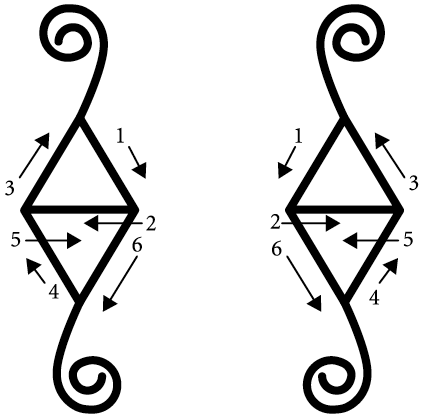
Om Benza Satto Hung
This is a purifying symbol that can be used in meditation and during treatment to draw up harmful energies so they may be transformed. In the Tera Mai tradition, it can be used to remove unwanted energies and reverse the effects of attunements to other traditions when they are deemed to be of human and not divine invention.
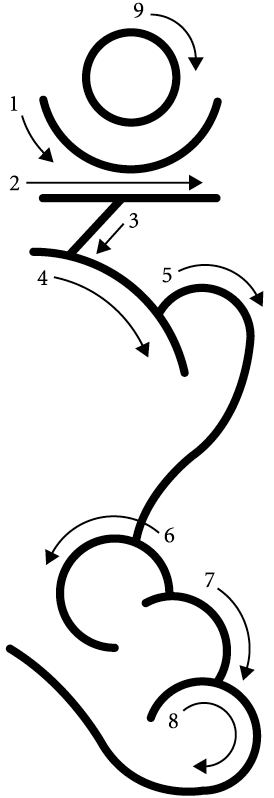
Figure 118: Om Benza Satto Hung
Other Reiki Symbols
Dai Zon
This is a shamanic symbol channeled by Lyn Roberts-Herrick, and it can be used to start and end a session. Some practitioners use Dai Zon by spiraling in toward the recipient’s heart center, moving inward through all of the chakras. The direction can be reversed to close the session. It means “from my heart to your heart,” and is pronounced DIE-don.36
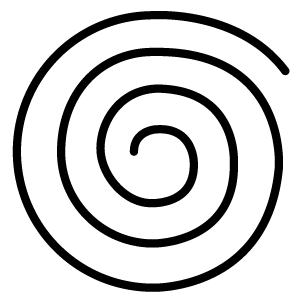
Johre
Pronounced JO-rey, this symbol is said to mean “white light,” and it will help in the release of unneeded or harmful energy, opens the chakras, and connects one to spirit guides.37

Len So My
This symbol represents pure, unconditional love and is associated with Earth Angels. It can surround you in the nurturing, protective energy of love while helping you to remain grounded and secure. This is an excellent symbol for healing feelings of abandonment and neglect.
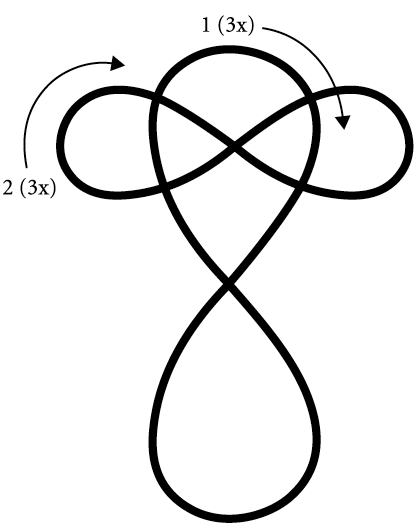
Lon Say
This symbol is used to dispel negativity and heal infections. Christopher Penczak recommends using this symbol down the entire body, beginning at the crown of the head, focusing the spiral in the chest area, and drawing the wavy lines over the abdominal region.38

Tam A Ra Sha
This symbol is used to bring balance to your entire being, and it is also useful for calming energetic upheaval and pain in the body. It is said to clear the chakras and meridians, allowing energy to flow more freely to all parts of the system.


There are more reiki symbols than what can be included here, with new ones being created or channeled, no doubt, as this book goes to press, and in your own practice, you, too, may receive symbols that can be used to enhance your healing work.
Using the Reiki Symbols
There are two basic ways of using the symbols: drawing them and visualizing them, and these methods can, of course, be combined. When drawing the symbols, you can do this with your finger or whole hand in the air, above the body or an object, in a chosen space, with the tip of the tongue inside the mouth, or by literally drawing them with pen on paper. Visualizing the symbol can be done in many ways, such as picturing the symbol in your mind’s eye, projecting your mental image of the symbol onto a body part or other physical location, or onto a distant recipient or place. While many teachers advise not drawing the symbols and displaying them publicly, you could draw them in your journal to bring healing to an event or issue. In magickal practice, the symbols can be carved into candles, used in sigil magick, or drawn on paper for spells.
Animals
While some animals may allow you to give reiki with direct touch, this is more difficult with others. By using Symbol Three, you can connect to the animal from a distance, and using Symbol One will amplify the energy transmission. See page 279 for additional techniques.
Distance Techniques
Certain symbols are associated with the ability to channel reiki to locations and recipients who are not physically present. See Chapter 14 for more information.
Food and Drink
You can trace the symbols over your food, draw the symbols into the condensation of a drinking glass, or draw the symbols into the cooking pot with a spoon. You can also give reiki to individual ingredients before making a recipe. Use the symbols to enhance the benefits of medications, vitamins, and other supplements.
Healing Issues or Challenging Situations
Write out the situation you desire to heal on a piece of paper, then hold it between your hands, setting the intention that reiki will flow into the situation, healing it on every level. Draw Symbol Three over the paper and intend that reiki connect with the situation, and repeat this process with Symbol Two, then Symbol One. Hold the paper, giving reiki for five to ten minutes, and when the energy flow tapers off, draw Symbol One once more, chanting the associated mantra three times. If you intend to repeat this exercise, place the paper somewhere safe, perhaps on an altar if you have one. If you are ending the process here, I like to burn the paper and put the ashes into the earth.
I have used this process in combination with tarot readings about a particular issue. After I perform the reading, gathering any necessary insights about the situation, I treat the layout with the same process as described with the piece of paper above (without burning my cards at the end, of course!). When done, I “reset” the cards by hovering my hands over the layout and giving reiki with the intention that the cards are cleansed on all levels, followed by making a horizontal chopping motion with my hand, three times over the cards.
Inanimate Objects
In magickal traditions, charging an object with reiki is akin to creating a talisman or an amulet. While the terms are often used interchangeably, some traditions specify that a talisman is used to attract energy or amplify existing energies, while amulets ward you from unwanted energies and influences. You can trace a symbol over the object (most commonly, Symbol One, although experiment and see if different symbols work best with certain objects), and then hold it in your hands to “fill it” with reiki. You can also use symbols over malfunctioning objects, like your car or computer, or preventatively, when the machine is working just fine.
A similar technique involves empowering objects with reiki, which serves the dual purpose of enhancing the object’s functioning while also setting it up as a reiki transmitter of sorts. For example, if you empower a clock, you can get a nice little reiki boost every time you look at it to check the time. The process is simple: draw Symbol One over the object, chanting the mantra three times, and holding the intention of filling the object with reiki so that it will emanate healing energy. You can do this with anything in your life, such as phones and other devices, shower heads, mirrors, clothing, beauty products, kitchen appliances, your favorite pen, bedding, furniture, your journal, and the list goes on!
Choose a comfy spot where you won’t be disturbed, and draw Symbol One on all four sides of you, above you, and below you, intending that you are protected from harm on all levels throughout this experience. I like to chant the mantra as I do this, feeling the sound clearing the space of any unwanted energy. Feel reiki surrounding you, and take a few breaths to calm and center yourself, hands in gasshô. If you work with any spirit guides (see Chapter 16) that feel appropriate for this work, you can call on them to help you in this past-life healing. Draw Symbol Four, chanting its mantra three times, and intend that this experience unfold in accordance with the highest good.
Draw Symbol Three and chant its mantra three times. Envision the symbol creating a bridge of reiki, and intend that it connects you to the past life most in need of healing right now. There are two options for this step:
1. Travel this bridge in your mind’s eye, entering this past life as an observer, exploring, asking questions, and emanating reiki from your entire being, healing everything you encounter. This method adds techniques of journey meditation.
2. Send reiki through this bridge, healing this past life without entering it. This is a slight variation on a standard distance treatment.
Continue giving reiki for as long as feels necessary, then return along the same bridge if using option one, coming back into your body and present time. With both options, see the bridge in front of you, and draw Symbol One over it, intending that the bridge is dissolving, no longer connecting you to this past life. Draw Symbol One on both palms, then clap three times, completely releasing any remaining links to that life. If you worked with spirit guides, thank them now. Perform kenyoku hô and end with hands in gasshô, giving thanks.
Plants
You can use Symbol Three to connect to plants at a distance (try this when you’re away on vacation and your plants need a little love) or use Symbol One to amplify the transmission of reiki while you place your hands on or over the plant. This can also be done for seeds prior to planting, to the watering can, and to any organic soil amendments.
Protection
Penelope Quest provides two methods for using Symbol One in a protective fashion that I find quite effective.39 For the first method, draw a large version of Symbol One in front of you, chant the mantra three times, and step into the symbol, imagining it surrounding you while focusing on the intention that you are protected from harm on all levels. The second method involves drawing Symbol One in front of you, on both sides, and visualizing drawing it behind you. Chant the mantra three times as you intend that it forms a protective shield all around you. If you like, you can draw the symbol over your head and under your feet, too.
You can use a similar method to create a protective barrier around your house, car, and so on. Draw Symbol One over the object and imagine it expanding to cover it completely, on all sides. If the object isn’t physically present, you can use Symbol Three first to create a connection before surrounding it with protective energy using Symbol One. I like to refresh this barrier on a regular basis. I might do this once a month under normal circumstances, but if I’m traveling, for example, I’ll refresh the shield on my car more frequently or do the same distantly on my house while I’m away.
Psychic Activation
I have found that simply using reiki on a regular basis fine-tunes my intuition and activates psychic senses, but you can also use the following process to enhance these abilities. Draw Symbol One and Symbol Two on the palm of each hand. Place one palm over your forehead and the other hand behind your head. Intend that reiki flow into your third eye chakra, activating your psychic abilities in the manner that is correct and good for you, and allow reiki to flow.
You can also prepare a tea of mugwort, lemon balm, and anise seed, charging each of the herbs with reiki using Symbol One and Symbol Two. Brew the tea and draw the symbols over the cup, intending to activate your psychic abilities in a manner that is correct and good for you. With hands in gasshô, focus on this intention while bringing awareness to your third eye. Drink some of the tea, and with each breath, let reiki flow into you, gathering at your third eye. Continue until the process feels complete, then finish with hands in gasshô, giving thanks.
If you find yourself overwhelmed by psychic input, use the techniques in the protection section, setting the intention that only helpful energies are permitted into your field and all other energies are deflected with love.
Purifying a Space
Draw a large version of a symbol into the space. Symbol One is often used here, although there are non-traditional symbols that work well, too, such as Hang Seng Dor and Kita No Kaze. Some practitioners advise drawing the symbol in each corner of the room, on each wall, on the ceiling, and on the floor, and I like to combine this with chanting one of the mantras, as the sound is a powerful aid in the cleansing process. You can also pair the symbols with other energetic cleansing techniques, such as smudging with sage or sweetgrass. Light the plant matter, blow out the flame, and disperse the smoke around the space. Leave a window open to allow unwanted energies a means of exit. You can also spray a dilution of sage or palo santo essential oil or Florida water around the room.
Purifying Yourself
Many of the techniques in Chapter 14 and Chapter 15 serve to purify your body and energy field, and here is an additional method. Draw a large Symbol One over the front of your body with your finger as follows: Start the horizontal bar at the top in front of your crown, then bring the vertical line down to your hara. With your finger pointing at the floor, draw the three spirals, imagining each one surrounding your body. Throughout this process, intend that reiki is cleansing you on all levels, and chant the associated mantra three times (I like to use the chant while tracing the three spirals).
Travel
Holding the intention that reiki protect you (and any traveling companions) throughout your trip, use the symbols to give reiki to your mode of transportation (car, plane, etc.) or to your destination (visualizing it in your mind or using a photo). You could use Symbol Three, followed by Symbol One, or any combination of symbols that feels best to you. Objects such as jewelry or clothing can also be charged with reiki in the same manner and worn during your travels. I really like this technique from Penelope Quest: “Draw the Distant Symbol, saying its mantra to yourself three times, and imagine it forming a bridge of light connecting you with your destination. … Imagine a Power Symbol traveling ahead, clearing the way for you along the bridge of light formed by the Distant Symbol.” 40

In this chapter, you learned about the traditional and non-traditional reiki symbols, as well as myriad uses for them. In the next chapter, we’ll cover another aspect of reiki practice: the five precepts and other philosophical teachings.
1. Stiene and Stiene, The Reiki Sourcebook, 84.
2. Doi, A Modern Reiki Method for Healing, 61.
3. Stiene and Stiene, The Reiki Sourcebook, 86.
4. Doi, A Modern Reiki Method for Healing, 62.
5. Stiene and Stiene, The Reiki Sourcebook, 95.
6. Stiene and Stiene, The Reiki Sourcebook, 93.
7. Stiene and Stiene, The Reiki Sourcebook, 95.
8. Doi, A Modern Reiki Method for Healing, 65.
9. Penelope Quest, Reiki for Life: The Complete Guide to Reiki Practice for Levels 1, 2 & 3 (New York: TarcherPerigee, 2016), 178; Frans Stiene, The Inner Heart of Reiki: Rediscovering Your True Self (Winchester, UK: Ayni Books, 2015), 71.
10. Stiene, The Inner Heart of Reiki, 66.
11. Stiene, The Inner Heart of Reiki, 179.
12. Stiene, The Inner Heart of Reiki, 77.
13. Stiene, The Inner Heart of Reiki, 79.
14. Doi, A Modern Reiki Method for Healing, 67.
15. Stiene, The Inner Heart of Reiki, 77.
16. Stiene, The Inner Heart of Reiki, 93.
17. Stiene, The Inner Heart of Reiki, 188.
18. Stiene, The Inner Heart of Reiki, 103.
19. Doi, A Modern Reiki Method for Healing, 75.
20. Stiene, The Inner Heart of Reiki, 98.
21. Maya Cointreau, The Practical Reiki Symbol Primer (self-published, CreateSpace, 2015), 18.
22. Laurelle Shanti Gaia, The Book on Karuna Reiki: Advanced Healing Energy for Our Evolving World (Hartsel, CO: Infinite Light Healing Studies Center, 2001), 65.
23. Brené Brown, The Gifts of Imperfection (Center City, MN: Hazelden, 2010), 19.
24. Gaia, The Book on Karuna Reiki, 67.
25. Christopher Penczak, Magick of Reiki: Focused Energy for Healing, Ritual & Spiritual Development (St. Paul, MN: Llewellyn Publications, 2004), 136.
26. Penczak, Magick of Reiki, 70.
27. Gaia, The Book on Karuna Reiki, 64.
28. Jarandhel Dreaminger, “Corey Thorn’s Reiki Symbols,” WanderingPaths, accessed April 27, 2019, http://wanderingpaths.dreamhart.org/reiki/coreysymbols.html.
29. Cointreau, The Practical Reiki Symbol Primer, 37.
30. Cointreau, The Practical Reiki Symbol Primer, 64.
31. Penczak, Magick of Reiki, 236.
32. Penczak, Magick of Reiki, 241.
33. Penczak, Magick of Reiki, 241.
34. Reikifire Ministry, “Wagle Reiki Symbols Index,” Reiki Spirit, last modified January 4, 2005, http://reikispirit.net/church/sym.lib.wagle.html.
35. Cointreau, The Practical Reiki Symbol Primer, 155.
36. Penczak, Magick of Reiki,141.
37. Penczak, Magick of Reiki, 138.
38. Penczak, Magick of Reiki, 149.
39. Quest, Reiki for Life, 219.
40. Quest, Reiki for Life, 220.